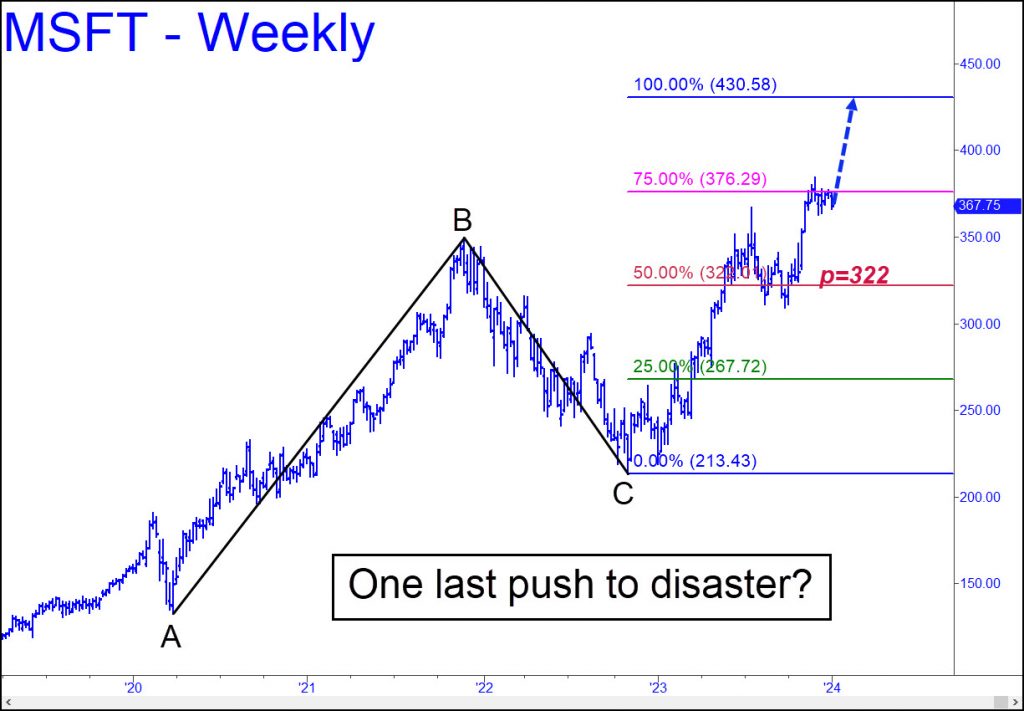
The stock market is so pumped with hubris, lies and delusions that I’m beginning to doubt whether the bull market will see Microsoft rally to $430 before everything comes crashing down. I’ve been using MSFT as a bellwether because it has been the strongest megacap stock in the world for the last four years, and because the company’s subscription-based revenues will continue to flow even in a severe economic downturn. The stock’s weekly chart implies it will make a very important top if and when it hits 430, but there are no guarantees it will get there. The chart’s bullishness is persuasive on this point because of the ease with which buyers exceeded the p=322 ‘midpoint pivot’ of the pattern. However, the implied power of the move would have been greater if the rally had impaled p and never looked back. Instead, MSFT took its sweet old time over a period of five months in turning the midpoint pivot into a launching pad. This, in my estimation, has made the stock an 80% likelihood to reach 430, as opposed to a 95% bet if buyers had pulverized p=322 on first contact.
So how do we deal with 20% uncertainty about how and when a top will occur? It is important to get this right, since the bear market that’s coming stands to bring even greater hardship to most Americans than the 1930s. People were more resourceful then, with 30% of the work force tied to agriculture, literally living off the land. They were not in hock up to their eyeballs, and women had the option of staying home with their children. The dollar was backed by gold and fundamentally sound. Government statistics tied to job creation, unemployment and GDP growth were not horse manure like the numbers shoveled at us today, and the economy was mostly brick-and-mortar rather than financialized beyond honest reckoning. These days, even eggheads at leading universities can’t tell for certain whether the economy is booming or dying. It is supposedly 60% consumption-driven, but as Main Street USA has become increasingly boarded up, only a relative handful of big retailers have survived. To make things worse, with the minimum wage headed inexorably toward $20, they have been investing heavily in ways to shrink their payrolls. ‘Strong’ job growth is a dirty lie, as anyone can plainly see; and if unemployment can be reported as unbelievably low, it is mainly because young people would rather not work. Lawyers are a tireless exception, but AI and hard times are about to decimate their ranks like an avenging angel.
No Dollar Alternatives
With trade in goods and services dwarfed by a paper-shuffling economy perhaps twenty times as large, our focus should be on the dollar, more than on Microsoft, to tell us when the financial system has begun to implode. It is logical to think the Fed’s monetization blowout, with yet another phase likely to begin in 2024, will cheapen the dollar. Some observers think greenbacks will be replaced by a form of gold, perhaps tokens. However, there are no alternatives to the dollar even remotely large enough to handle the $2 quadrillion of speculative action enabled by the derivatives market. When this house of cards implodes, triggered by who-knows-what, it will shrink the fungible supply of dollars so severely as to cause a short squeeze on dollars. Traders in particular understand how this can propel the nominal value of even worthless securities into the stratosphere. The same could happen to a dollar that already is just a heavily encumbered IOU. And although the short squeeze would likely be over quickly, it would take but a few days to turn the economy and the banking system into smoldering ruin.
That’s why we should keep a close eye on the dollar, which has been falling since the last quarter of 2022. The decline could accelerate as Putin, China, the BRICs, oil producers, the Houthis and just about everyone else continue to humiliate into oblivion the waning myth of American power and influence. But don’t expect the dollar to go quietly into the night. Its sinking spell could be likened to the receding tide that precedes a tsunami. When the big wave comes, few who owe dollars will be able to survive financially. A stock-market plunge will signal the impending disaster, and we can expect it to begin visibly just as the Fed announces its first rate-cut in years.

